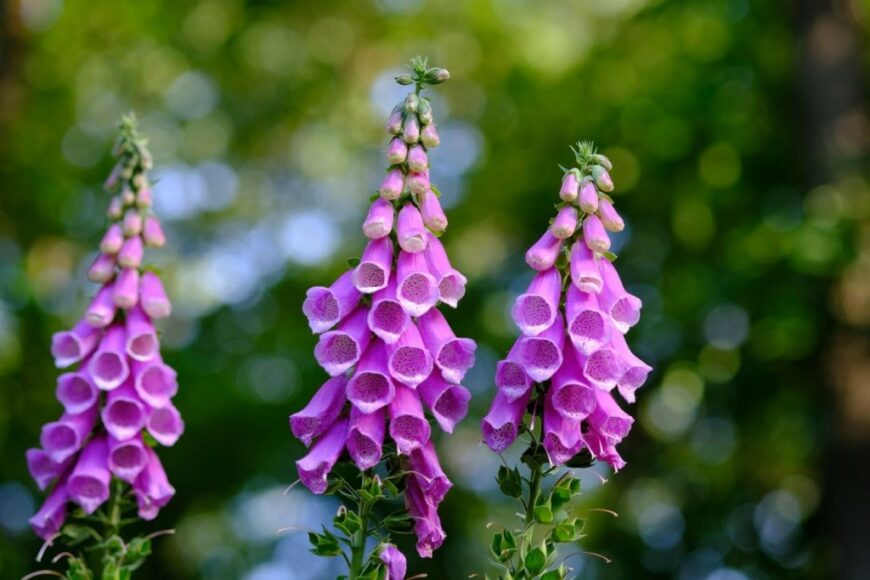
 Name:Foxglove, Scientific name: Digitalis Common, Other names: Fairy fingers, lady's gloves, witch's bells
Name:Foxglove, Scientific name: Digitalis Common, Other names: Fairy fingers, lady's gloves, witch's bells Family: Plantaginaceae
Family: Plantaginaceae Origins: Europe, Western Asia, and northwestern Africa
Origins: Europe, Western Asia, and northwestern Africa Humidity: Moderate humidity
Humidity: Moderate humidity Location: Partial shade to full shade
Location: Partial shade to full shade Soil: Moist, well-drained soil
Soil: Moist, well-drained soil Pests and diseases: Slugs, snails, powdery mildew, foxglove rust
Pests and diseases: Slugs, snails, powdery mildew, foxglove rust Care: Water foxgloves regularly, especially during dry periods. Mulch around the plants to help retain moisture. Deadhead spent flowers to encourage continued blooming.
Care: Water foxgloves regularly, especially during dry periods. Mulch around the plants to help retain moisture. Deadhead spent flowers to encourage continued blooming. Height of growth: 2-6 feet tall
Height of growth: 2-6 feet tall Planting in the soil: Plant foxgloves in the spring or fall. Dig a hole that is twice as wide as the root ball. Gently place the root ball in the hole and backfill with soil. Water thoroughly.
Planting in the soil: Plant foxgloves in the spring or fall. Dig a hole that is twice as wide as the root ball. Gently place the root ball in the hole and backfill with soil. Water thoroughly. Blooming: Foxgloves bloom in late spring to early summer.
Blooming: Foxgloves bloom in late spring to early summer.Foxglove, scientifically known as Digitalis purpurea, is a captivating and iconic plant renowned for its tall spires of tubular flowers. Beyond its aesthetic appeal, Foxglove holds historical significance, often associated with enchantment and various cultural beliefs.
Content:
Growing Foxglove: From Seeds to Blooms
- Selecting the Right Location:
- Choose a partially shaded area to protect Foxglove from intense sunlight, mimicking its natural woodland habitat.
- Planting Foxglove Seeds:
- Sow seeds in late winter or early spring in well-draining soil for successful germination.
- Soil Requirements for Optimal Growth:
- Provide moist, well-drained soil enriched with organic matter to support Foxglove’s vigorous growth.
Caring for Foxglove Plants
- Watering Guidelines:
- Maintain consistently moist soil, especially during dry periods, to keep Foxglove thriving.
- Sunlight Requirements:
- Choose a location with partial shade, as excessive sunlight can be detrimental to Foxglove.
- Pruning Techniques for a Healthy Plant:
- Deadhead spent blooms regularly to encourage continuous flowering and prevent self-seeding.
Exploring the Diverse Varieties of Foxglove
- Overview of Common Foxglove Varieties:
- Explore popular types like Dalmatian, Foxy, and Camelot, each offering unique colors and characteristics.
- Highlighting Unique Colors and Characteristics:
- From traditional pinks to striking purples and whites, Foxglove provides a spectrum of colors for your garden palette.
Foxglove in Gardens and Landscapes
- Landscaping Ideas Incorporating Foxglove:
- Utilize Foxglove’s vertical growth for stunning borders or focal points in your garden.
- Companion Plants that Complement Foxglove:
- Pair Foxglove with companions like hostas and ferns for a harmonious and visually appealing garden.
- Understanding the Potential Risks:
- Be aware that Foxglove is toxic, especially if ingested. Exercise caution, especially if you have pets or small children.
- Implementing Safety Precautions:
- Wear gloves when handling Foxglove and educate household members about its potential toxicity.
Foxglove’s Medicinal Uses: Past and Present
- Historical Medicinal Applications:
- Delve into the historical use of Foxglove in herbal medicine, particularly its association with heart-related treatments.
- Modern Research on Foxglove’s Medicinal Properties:
- Explore contemporary studies on Foxglove’s potential applications in modern medicine.
Frequently Asked Questions (FAQ)
Can I grow Foxglove from seeds?
Yes, sow Foxglove seeds in well-draining soil in late winter or early spring for successful germination.
How do I prevent Foxglove from self-seeding everywhere?
Deadhead spent blooms regularly to discourage self-seeding and promote continuous flowering.
Are there non-toxic alternatives to Foxglove for gardens with pets and children?
Consider planting pet-friendly and child-safe flowers like marigolds and sunflowers.
Can I use Foxglove medicinally at home?
While historically used in herbal medicine, it’s crucial to consult a healthcare

